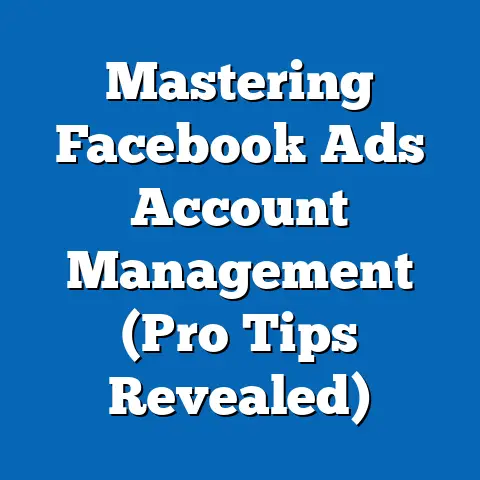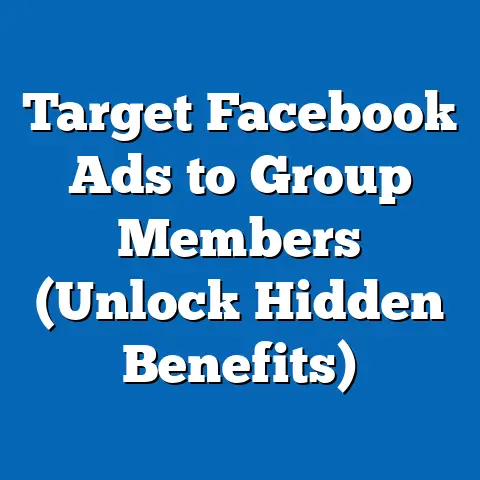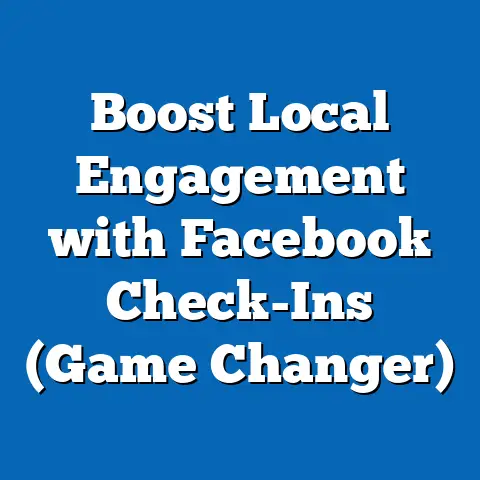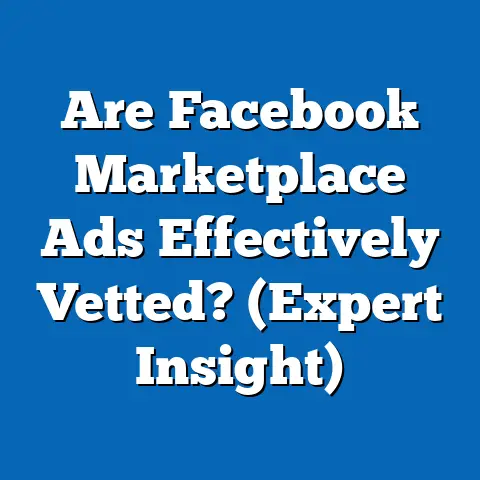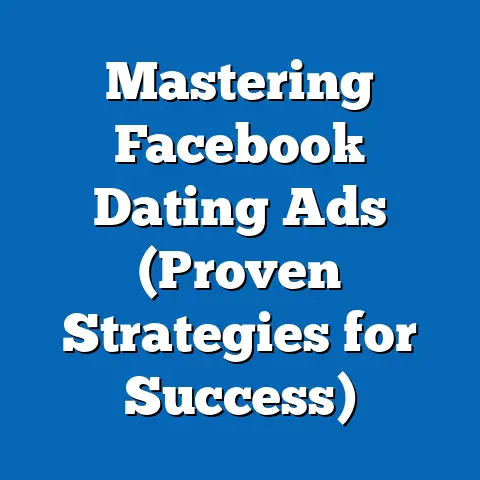Boost Engagement with Facebook Mobile App Ads (Pro Secrets)
Have you ever started a home renovation project, only to uncover hidden potential you never knew existed? Maybe you peeled back old wallpaper to find a stunning brick wall, or discovered a forgotten room behind a dusty bookcase. These unexpected discoveries often transform the entire vision, leading to something even better than you initially imagined.
Understanding Facebook Mobile App Ads
Facebook mobile app ads are specifically designed to promote your mobile application on the Facebook platform. Their primary purpose is to drive app installs and encourage engagement with existing users. Think of them as targeted invitations to your app, reaching potential users where they spend a significant portion of their time.
There are two main types of Facebook mobile app ads:
-
App Install Ads: These ads are focused on driving new downloads of your app. They typically feature a prominent “Install Now” or “Download” call-to-action (CTA) that directs users to the app store.
-
App Engagement Ads: These ads are geared towards re-engaging existing users of your app. They encourage users to return to the app and take specific actions, such as completing a purchase, leveling up in a game, or inviting friends.
App Install Ads: These ads are focused on driving new downloads of your app. They typically feature a prominent “Install Now” or “Download” call-to-action (CTA) that directs users to the app store.
App Engagement Ads: These ads are geared towards re-engaging existing users of your app. They encourage users to return to the app and take specific actions, such as completing a purchase, leveling up in a game, or inviting friends.
Mobile apps have become an integral part of our daily lives. They offer convenience, entertainment, and instant access to information. For businesses, mobile apps serve as a direct line to consumers, allowing them to build relationships, offer personalized experiences, and drive sales.
Consider these statistics:
- In 2023, the average smartphone user spent over 4 hours per day using mobile apps. (Source: Statista)
- Mobile apps are projected to generate over $693 billion in revenue by 2025. (Source: Statista)
- Users are 138% more likely to purchase through a mobile app than a mobile website (Source: Criteo)
These numbers clearly demonstrate the importance of having a strong mobile presence and leveraging mobile app ads to reach and engage your target audience. I’ve seen countless businesses struggle to connect with their customers through traditional channels, only to find incredible success with a well-optimized mobile app and a strategic Facebook ad campaign.
Key Takeaway: Facebook mobile app ads are a powerful tool for driving app installs and re-engaging existing users. Understanding the different types of ads and the importance of mobile apps in today’s digital landscape is crucial for success.
The Importance of Engagement
Engagement, in the context of mobile apps, refers to the level of interaction and involvement users have with your app. It’s not just about downloading your app; it’s about actively using it, exploring its features, and finding value in its offerings. A highly engaged user is one who frequently opens your app, spends a significant amount of time using it, and interacts with its various features.
Why is engagement so critical for businesses? Because it directly impacts your bottom line. Here’s a breakdown of the key benefits of high user engagement:
- Improved Customer Retention: Engaged users are less likely to abandon your app. They’ve invested time and effort into learning its features and building habits around its use. This leads to higher retention rates and a more stable user base.
- Increased Lifetime Value (LTV): Highly engaged users generate more revenue over their lifetime. They are more likely to make in-app purchases, subscribe to premium features, and recommend your app to others.
- Positive Word-of-Mouth: Engaged users are more likely to become advocates for your app. They’ll share their positive experiences with friends and family, write glowing reviews, and contribute to your app’s overall reputation.
- Valuable Feedback and Insights: Engaged users are more likely to provide feedback and suggestions for improvement. This valuable input can help you refine your app, address pain points, and create a better user experience.
I remember working with a gaming app that was struggling to retain users. They had a great game, but their engagement metrics were abysmal. We launched a Facebook app engagement campaign targeting users who hadn’t opened the app in over a week, offering them exclusive in-game rewards for returning. The results were incredible. We saw a significant increase in daily active users (DAU), a boost in in-app purchases, and a surge in positive reviews. This experience solidified my belief in the power of engagement and the impact it can have on a business’s success.
Here are a few examples of successful mobile apps that have leveraged Facebook ads to boost engagement:
- Duolingo: The language learning app uses Facebook app engagement ads to remind users to practice their skills and complete lessons. They often feature personalized messages based on the user’s learning progress.
- Spotify: The music streaming app uses Facebook app engagement ads to encourage users to discover new music, create playlists, and share their favorite songs with friends.
- Headspace: The meditation app uses Facebook app engagement ads to promote daily meditation sessions and encourage users to track their progress.
These examples demonstrate the diverse ways in which Facebook app engagement ads can be used to drive user engagement and achieve specific business goals.
Key Takeaway: Engagement is crucial for the success of your mobile app. It leads to improved customer retention, increased lifetime value, positive word-of-mouth, and valuable feedback.
Pro Secrets to Boost Engagement with Facebook Mobile App Ads
Now, let’s dive into the pro secrets that will help you boost engagement with your Facebook mobile app ads. These are the strategies and tactics I’ve learned through years of experience and countless campaigns.
Secret 1: Targeting the Right Audience
The foundation of any successful Facebook ad campaign is precise audience targeting. You can have the most creative ad in the world, but if it’s shown to the wrong people, it will fall flat. Facebook’s targeting tools are incredibly powerful, allowing you to reach the most relevant users for your app based on a variety of factors.
Here are some of the key targeting options you should consider:
- Demographics: Target users based on age, gender, location, education, and other demographic factors.
- Interests: Target users based on their interests, hobbies, and passions. Facebook gathers this information from the pages they like, the groups they join, and the content they engage with.
- Behaviors: Target users based on their online behaviors, such as their purchase history, their mobile device usage, and their travel habits.
- Custom Audiences: Create custom audiences based on your existing customer data, such as email lists or website visitors. This allows you to target users who are already familiar with your brand.
- Lookalike Audiences: Expand your reach by creating lookalike audiences based on your existing customer data. Facebook will find users who share similar characteristics and behaviors with your best customers.
I always recommend starting with a broad audience and then gradually narrowing it down based on performance data. Use Facebook’s Audience Insights tool to gain a deeper understanding of your target audience and identify potential targeting opportunities.
For example, let’s say you’re promoting a fitness app. You could target users who are interested in fitness, health, and wellness, and who have shown an interest in specific fitness activities, such as running, yoga, or weightlifting. You could also target users who have recently purchased fitness equipment or apparel online.
Key Takeaway: Precise audience targeting is essential for the success of your Facebook mobile app ads. Use Facebook’s targeting tools to reach the most relevant users for your app based on demographics, interests, behaviors, custom audiences, and lookalike audiences.
Secret 2: Crafting Compelling Ad Creatives
Your ad creative is the first thing users will see, so it’s crucial to make a strong impression. Your ad creative should be visually appealing, informative, and relevant to your target audience.
Here are some best practices for designing eye-catching ad creatives:
- Use High-Quality Images and Videos: Your images and videos should be clear, crisp, and visually appealing. Avoid using blurry or low-resolution images.
- Highlight Your App’s Unique Value Proposition: Clearly communicate the benefits of your app and what makes it stand out from the competition.
- Use Strong CTAs (Call-to-Action): Tell users exactly what you want them to do, such as “Install Now,” “Download,” or “Learn More.”
- Keep Your Messaging Concise and Clear: Avoid using jargon or overly technical language. Your messaging should be easy to understand and relevant to your target audience.
- Use a Consistent Brand Identity: Your ad creatives should align with your overall brand identity, including your logo, colors, and fonts.
There are several types of ad creatives you can use for your Facebook mobile app ads:
- Images: Single images can be effective for showcasing your app’s features or highlighting its unique value proposition.
- Videos: Videos are a great way to demonstrate how your app works and engage users with dynamic content.
- Carousels: Carousels allow you to showcase multiple images or videos in a single ad. This is a great option for highlighting different features of your app or telling a story.
I’ve found that videos tend to perform particularly well for app install ads. A short, engaging video that demonstrates the app’s functionality and benefits can be highly effective in driving downloads.
Key Takeaway: Your ad creative is the first thing users will see, so it’s crucial to make a strong impression. Use high-quality images and videos, highlight your app’s unique value proposition, use strong CTAs, and keep your messaging concise and clear.
Secret 3: Utilizing A/B Testing
A/B testing, also known as split testing, is the process of comparing two or more versions of an ad to see which one performs better. This is a crucial step in optimizing your Facebook mobile app ads and ensuring that you’re getting the best possible results.
Here’s how to set up A/B tests effectively:
- Choose a Variable to Test: Select one element of your ad to test, such as the headline, the image, or the CTA.
- Create Two Versions of Your Ad: Create two versions of your ad, each with a different variation of the variable you’re testing.
- Run Your Ads: Run both versions of your ad simultaneously, targeting the same audience.
- Track Your Results: Track the performance of each ad, paying attention to metrics such as click-through rate (CTR), conversion rate, and cost per acquisition (CPA).
- Analyze Your Results: Analyze the results of your A/B test to determine which version of your ad performed better.
- Implement the Winning Variation: Implement the winning variation of your ad in your ongoing campaigns.
I always recommend testing one variable at a time to ensure that you can accurately attribute the results to the specific change you made. Don’t try to test too many things at once, or you’ll end up with inconclusive results.
For example, you could A/B test two different headlines to see which one generates more clicks. Or, you could A/B test two different images to see which one is more visually appealing to your target audience.
Key Takeaway: A/B testing is a crucial step in optimizing your Facebook mobile app ads. Test different ad formats and messaging to find what resonates best with users.
Secret 4: Optimizing for App Events
App events are actions that users take within your app, such as completing a purchase, leveling up in a game, or inviting friends. Tracking app events is essential for understanding how users are engaging with your app and optimizing your ads accordingly.
You can set up app events using the Facebook SDK (Software Development Kit), which is a set of tools that allows you to integrate your app with Facebook. Once you’ve installed the Facebook SDK, you can start tracking a variety of app events, such as:
- App Installs: Track when users install your app.
- App Opens: Track when users open your app.
- In-App Purchases: Track when users make purchases within your app.
- Level Completions: Track when users complete levels in your game.
- Content Views: Track when users view specific content within your app.
Once you’re tracking app events, you can use this data to optimize your ads in several ways:
- Target Users Who Are Likely to Take Specific Actions: Target users who have previously taken specific actions within your app, such as making a purchase or completing a level.
- Create Lookalike Audiences Based on High-Value Users: Create lookalike audiences based on users who have taken valuable actions within your app, such as making multiple purchases or inviting a large number of friends.
- Optimize Your Ads for Specific App Events: Optimize your ads to drive specific app events, such as in-app purchases or level completions.
I’ve seen incredible results by optimizing ads based on user behavior within the app. For example, we worked with an e-commerce app that was struggling to drive sales. We implemented app event tracking and discovered that users who viewed a specific product category were more likely to make a purchase. We then created a Facebook ad campaign targeting users who had viewed that product category, offering them a special discount. This campaign resulted in a significant increase in sales and a much higher return on ad spend (ROAS).
Key Takeaway: Tracking app events is essential for understanding how users are engaging with your app and optimizing your ads accordingly. Use the Facebook SDK to set up app event tracking and optimize your ads to drive specific app events.
Secret 5: Leveraging Retargeting Strategies
Retargeting is the process of showing ads to users who have previously interacted with your app or website. This is a highly effective strategy for re-engaging users who have shown interest in your app but haven’t completed desired actions, such as making a purchase or signing up for a subscription.
There are several ways to leverage retargeting strategies for your Facebook mobile app ads:
- Target Users Who Have Abandoned Their Shopping Cart: Show ads to users who have added items to their shopping cart but haven’t completed the purchase. Offer them a discount or free shipping to encourage them to complete the transaction.
- Target Users Who Have Viewed Specific Products or Content: Show ads to users who have viewed specific products or content within your app or website. Highlight those products or content in your ads to remind them of their interest.
- Target Users Who Have Installed Your App But Haven’t Used It in a While: Show ads to users who have installed your app but haven’t used it in a while. Offer them exclusive in-game rewards or new content to encourage them to return to the app.
I remember working with a travel app that was struggling to convert users who had searched for flights but hadn’t booked them. We implemented a retargeting campaign that showed ads to these users, featuring the flights they had previously searched for. We also included a special discount to incentivize them to book. This campaign resulted in a significant increase in flight bookings and a much higher conversion rate.
Key Takeaway: Retargeting is a highly effective strategy for re-engaging users who have shown interest in your app but haven’t completed desired actions. Use retargeting to target users who have abandoned their shopping cart, viewed specific products or content, or installed your app but haven’t used it in a while.
Secret 6: Monitoring and Analyzing Performance
Continuous monitoring and analysis of ad performance metrics is crucial for the long-term success of your Facebook mobile app ads. You need to track key metrics such as CPC (cost per click), CTR (click-through rate), and engagement rate to understand what’s working and what’s not.
Here are some of the key metrics you should track:
- CPC (Cost Per Click): The amount you pay each time someone clicks on your ad.
- CTR (Click-Through Rate): The percentage of users who click on your ad after seeing it.
- Conversion Rate: The percentage of users who complete a desired action after clicking on your ad, such as installing your app or making a purchase.
- CPA (Cost Per Acquisition): The amount you pay for each acquisition, such as an app install or a purchase.
- Engagement Rate: The percentage of users who engage with your ad, such as liking, commenting, or sharing it.
By tracking these metrics, you can identify areas for improvement and optimize your ads accordingly. For example, if your CPC is high, you may need to refine your targeting or improve your ad creative. If your CTR is low, you may need to make your ad more visually appealing or more relevant to your target audience.
I recommend setting up a regular reporting schedule to track your ad performance and identify trends over time. This will allow you to make data-driven decisions and optimize your ads for maximum impact.
Key Takeaway: Continuous monitoring and analysis of ad performance metrics is crucial for the long-term success of your Facebook mobile app ads. Track key metrics such as CPC, CTR, conversion rate, and engagement rate to understand what’s working and what’s not.
Case Studies
Let’s take a look at a few real-world examples of businesses that have successfully boosted engagement through Facebook mobile app ads:
Case Study 1: Language Learning App
- Challenge: Low user engagement and high churn rate.
- Strategy: Launched a Facebook app engagement campaign targeting users who hadn’t opened the app in over a week, offering them exclusive in-game rewards for returning.
- Results: Significant increase in daily active users (DAU), a boost in in-app purchases, and a surge in positive reviews.
Case Study 2: E-Commerce App
- Challenge: Struggling to drive sales.
- Strategy: Implemented app event tracking and discovered that users who viewed a specific product category were more likely to make a purchase. Created a Facebook ad campaign targeting users who had viewed that product category, offering them a special discount.
- Results: Significant increase in sales and a much higher return on ad spend (ROAS).
Case Study 3: Travel App
- Challenge: Struggling to convert users who had searched for flights but hadn’t booked them.
- Strategy: Implemented a retargeting campaign that showed ads to these users, featuring the flights they had previously searched for. Included a special discount to incentivize them to book.
- Results: Significant increase in flight bookings and a much higher conversion rate.
These case studies demonstrate the power of Facebook mobile app ads and the impact they can have on a business’s success.
Conclusion
In conclusion, Facebook mobile app ads are a powerful tool for boosting engagement and driving app downloads. By understanding the different types of ads, targeting the right audience, crafting compelling ad creatives, utilizing A/B testing, optimizing for app events, leveraging retargeting strategies, and monitoring and analyzing performance, you can unlock new levels of engagement and growth for your app.
Just as renovations can unveil the hidden potential of a physical space, effectively utilizing Facebook mobile app ads can reveal untapped engagement opportunities for your business. Don’t be afraid to experiment, test new strategies, and adapt your approach based on the results you see.
Remember, the key to success is to focus on providing value to your users and creating a positive user experience. By doing so, you can build a loyal user base and drive long-term growth for your app.
Now it’s your turn to start experimenting with Facebook mobile app ads and share your own success stories or questions in the comments section. I’m eager to hear about your experiences and help you unlock the full potential of your app!

